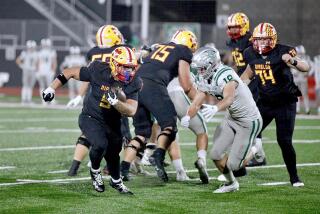Future of Big West Appears Up for Discussion
- Share via
When Nevada was admitted to the Western Athletic Conference last month, it was the fall of a domino that might cause repercussions throughout the Big West Conference.
Big West athletic directors will meet in Boise, Idaho, beginning Tuesday, to discuss the future of the conference and its potential configuration after the turn of the century.
Without Nevada, the Big West would be left with five schools that play Division I-A football--Boise State, Idaho, Utah State, New Mexico State and North Texas--and an affiliate member for football, Arkansas State.
None of the six California schools in the Big West play Division I-A football, and one possibility mentioned is the return of the conference to its roots as an all-California conference.
“If there is a breakup on the football side of the conference, then an all-California conference makes sense to me,” Long Beach State President Robert Maxson said. “When Nevada left, that put that side of the conference in a fragile position. I think the California schools are in a strong position. We’re not at the mercy of who goes where.”
Maxson said he believes an all-California conference would provide a targeted audience that might be attractive for regional television coverage.
Maxson points out that some of the money saved on travel with such a conference could be used to schedule more attractive nonconference matchups.
“It costs money sometimes to bring in top teams because of guarantees,” Maxson said, “but I’d like to offer our fans the opportunity to see some really good teams from outside our area in all sports.”
The idea appears to have support among other California members.
“What we want to create is a conference of like institutions that won’t have the desire to go elsewhere,” UC Irvine Athletic Director Dan Guerrero said. “We feel the future of the conference doesn’t have Division I football as part of the equation.”
Nevada won’t be leaving until after the 1999-2000 season, and Dennis Farrell, the conference’s commissioner, said the Big West is committed to an 11-school configuration for 2000-01. But what happens after that is uncertain. Any changes for the 2001-02 season have to be made before July 1, 2000, according to conference bylaws.
“The athletic directors of the California schools have made known the direction they would like to see the conference move,” Farrell said. “I can see some value to an all-California conference, but a lot of things would have to fall into place for that to happen.
“Our bylaws don’t allow members to be voted out, so it behooves everyone to work together to try to find answers that are in the best interest of all our schools.”
Farrell said options range from keeping the status quo after Nevada leaves, to expanding to two eight-team divisions, with no competition between the divisions until postseason playoffs.
One possibility Boise State Athletic Director Gene Bleymaier mentioned would be for the Division I-A football-playing schools to form a separate conference for football and remain members of the Big West in all other sports.
The potential also exists for other Big West schools eventually to follow Nevada into the WAC. The constant threat of secession has left some schools concerned about the conference’s image.
WAC Commissioner Karl Benson said his conference considered New Mexico State, Utah State and Boise State at the time it approved Nevada as its ninth member, but stopped short of offering more than one invitation.
“At some point, we think the WAC will be a 12-team league,” Benson said. “But our members decided that they wanted to move more slowly. They wanted to put some time between the WAC breakup, and see what might happen in other conferences. But, unless other schools become available, the pool of Big West teams makes sense for us geographically.”
Eight of the WAC’s 16 members left after last season, forming the Mountain West Conference that begins play this fall. Remaining in the WAC are Southern Methodist, Texas Christian, Texas El Paso, Rice, Tulsa, Hawaii and former Big West members Fresno State and San Jose State, with Nevada to become the ninth team. The Mountain West--Nevada Las Vegas, Brigham Young, Colorado State, Utah, Air Force, New Mexico, San Diego State and Wyoming--is not expected to expand for at least three years.
Sun Belt Conference Commissioner Wright Waters said his conference is considering a move to Division I-A football, which might create more options.
“We’ve made no secret we’re going in that direction,” Waters said. “If we could find the right mix of teams, I think it could happen quickly. But we have no timetable at this point.”
The Sun Belt currently has three teams--Arkansas State, Louisiana Tech and Southwestern Louisiana--playing Division I-A football. Waters says Western Kentucky plans to move to I-A from I-AA, and that Southern Alabama and Florida International are planning to start football programs. Wright calls North Texas “a very viable school for us.” New Mexico State might also be a possibility.
The Big Sky Conference has indicated interest in some of the Big West schools, but it plays Division I-AA football, not Division I-A.
“We would be willing to try to negotiate a new level of football for the conference somewhere between the 63 scholarships of Division I-AA and the 85 allowed by Division I-A, to let the Big West teams stay Division I-A,” Big Sky Commissioner Doug Fullerton said.
The Big Sky has two schools--Cal State Northridge and Sacramento State--that are regarded as potential Big West members if the conference adds California teams. Another Big Sky school, Northern Arizona, has been mentioned as a Big West possibility, but Athletic Director Steve Holton says his school has no interest in a change.
Northridge’s football program and its membership in the Big Sky might be in jeopardy. The conference is demanding the school build an on-campus stadium and improve other athletic facilities.
Sacramento State plays in the Big West in baseball as an affiliate member, but Athletic Director Debby Colberg says she has been happy with the Big Sky.
“It’s important to us to play football, and we would be reluctant to try to play Division I-AA football as an independent,” she said.
Cal Poly San Luis Obispo has continued as an independent in Division I-AA football since joining the Big West in 1996-97. “It’s possible that an arrangement could be worked out outside the conference to accommodate the schools that want to play Division I-AA football,” San Luis Obispo Athletic Director John McCutcheon said.
UC Riverside is moving to Division I status this year, and has already expressed interest in joining the Big West when it becomes eligible in two years.
Farrell said Riverside is regarded as “a viable prospect,” but said he has no indications of any interest from Northridge or Sacramento State. Another California school, UC Davis, is Division II and has not shown interest in moving up, according to an athletic department spokesman.
Ultimately, the conference presidents will decide the conference’s direction.
One of the most immediate issues facing the athletic directors is replacing Nevada as the site for the Big West basketball tournaments after next season. Irvine’s Bren Center and the Pyramid at Long Beach State are possibilities.
“We’ve asked all the schools if they are interested,” Farrell said, “and we’ll see what responses we have at the meeting.”
More to Read
Go beyond the scoreboard
Get the latest on L.A.'s teams in the daily Sports Report newsletter.
You may occasionally receive promotional content from the Los Angeles Times.










